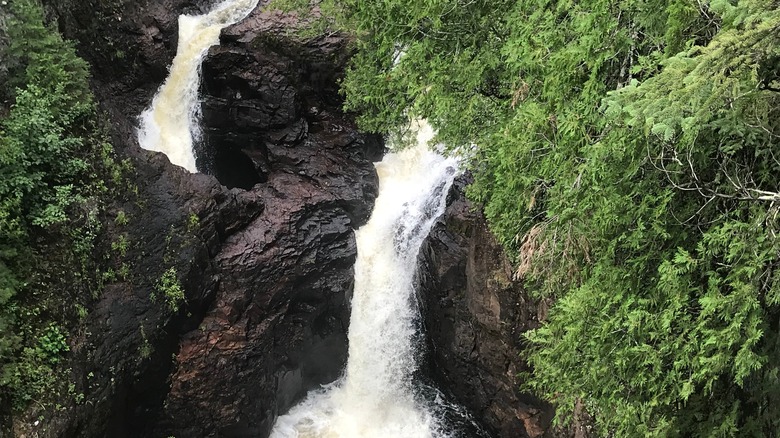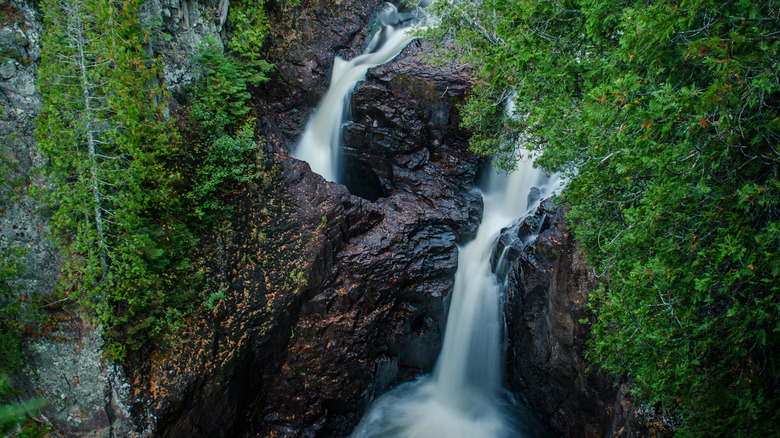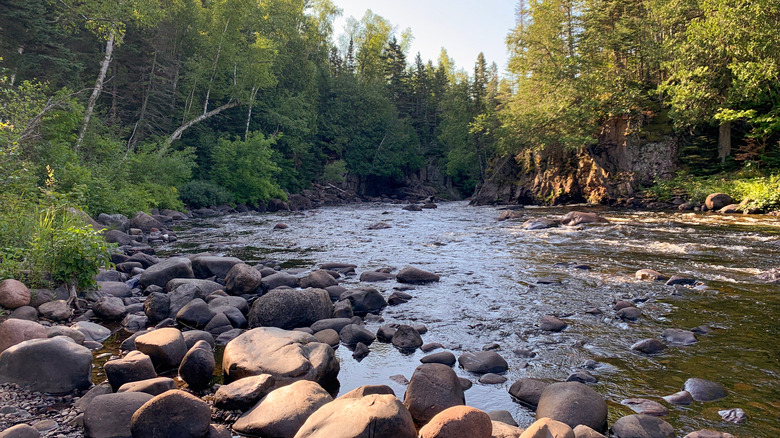The Mysterious 'Waterfall To Nowhere' Is A Unique 'Lake Superior Gem,' Per Samantha Brown
Tucked away in the forests surrounding Lake Superior, Minnesota, near adventure-packed yet remote Midwestern national parks, the roaring Brule River rages over rocky obstacles in white water rapids and whirlpools. The stream eventually plunges over a set of twin falls where the water splits between two crags of cliff. While one waterfall neatly dumps into the river underneath, the second, slightly higher cascade seemingly has no end — it looks like it disappears into thin air after depositing into the Devil's Kettle, the cauldron below. For a long time, where that water went was a mystery. This odd disappearing act confounded people for decades and even captured the heart of famed traveler, Samantha Brown, who called the Devil's Kettle Waterfall a "geological mystery." Brown lauds Judge C.R. Magney State Park, home of the bamboozling Devil's Kettle, as a must-visit in a typically regarded fly-over state and revels in the waterfall's unique story. Lake Superior is home to a number of massive yet underrated state parks, and Judge Magney and the Devil's Kettle are no exception.
Devil's Kettle is a Lake Superior gem that exhibits millennia of powerful volcanic activity. The almost 2-mile out and back trail within the state park will bring you right alongside the calmer Upper Falls, then over a series of bridges that show off gorgeous vistas, and eventually to the Devil's Kettle itself. Overall, the state park offers 9 miles of trails where you can get up close with the mighty Brule River and see some of the best views of Lake Superior. And, if the mystery moves you, like it did with Brown, you can even conduct your own sort-of experiment on the Devil's Kettle falls too.
Famous Devil's Kettle theories
Samantha Brown calls Devil's Kettle a "peculiar waterfall," and generations of travelers and researchers would have to agree that the falls-to-nowhere is both a delight and a quandary. Theories attempted to explain where half of the water was disappearing to. Some surmised that it was flowing into Canada via underground passageways either from lava tubes or an underground river. Understandable, considering how close Judge C.R. Magney State Park is to Canada's La Verendrye Provincial Park, just 47 miles up Highway 61. Others speculated that the higher waterfall simply had no bottom and did not stop.
Generations of park goers claimed that they had conducted their own experiments, dropping ping pong balls, logs, and even road signs over the edge to see if and when the items would reemerge. Evidently, none of them came back up to the surface, supporting theories that the Devil's Kettle really was bottomless. Another local tale chronicled a curious young man's adventure rappelling down 26 feet into the cauldron where the endless waterfall pours into ... he purportedly could never see the bottom despite going almost three stories underground. As it turns out, though, there is some scientific reasoning to the Devil's Kettle Falls mystery. Brown, ever the fan of the fantastical, does admit with some lament that after decades of confusing and entertaining visitors, locals, and researchers, there is a logical explanation.
What's really going on at Devil's Kettle Falls?
Despite enthusiast theories of underground tunnels, former Minnesota Department of Natural Resources hydrologist Jeff Green, believed that the missing water from the falls isn't actually missing — it just rejoins somewhere downstream. From 2016 to 2017, researchers from the DNR and the University of Minnesota conducted experiments and took measurements of the water flow between the Brule River and after the cascades. These measurements examined if there was any water loss from the top of the falls to after it went over the edge to see if one of the twin streams actually was dumping aqua somewhere other than the river below. As it turns out, virtually the same amount of water was measured between the two points, suggesting that the mysterious fall-without-an end actually exits into the same river its twin does.
So what about the items that vanished when people played scientist? Calvin Alexander from the University of Minnesota clears up the mystery, attributing the disappearing objects to the mighty power of the Devil's Kettle Waterfalls. The currents below are "capable of disintegrating material and holding it under water until it resurfaces at some point downstream," meaning the objects broke up somewhere in their journey over the cascades or took a long trip down the river.
While science has shed a light on the hydraulic phenomenon at Devil's Kettle Waterfalls, it doesn't deter Brown from musing on fantastical alternatives for fun. Maybe it's an undiscovered portal to another world, or the secret liar for a lake monster? No, science doesn't support these theories, but it's just a bit of fun to think about. Regardless, Judge C.R. Magney State Park — and the Lake Superior gem of Devil's Kettle — is a unique stop whether you're on a scenic road trip in the Midwest, exploring parks along the Canadian border, or looking for a fun getaway.


